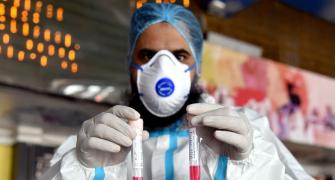Scientists have used virus-like particles to predict how environmental factors affect the survival of the novel coronavirus on surfaces, and found that the COVID-19 virus may remain infectious longer as temperatures drop in winter.

According to the study, published in the journal Biochemical and Biophysical Research Communications, virus-like particles, or VLPs, 'faithfully mimic the external structure of the SARS-CoV-2 virus'.
The researchers from the University of Utah in the US said the VLPs are empty shells made of the same lipids and three types of proteins as present in an active SARS-CoV-2 virus, but without its genetic material RNA that causes infections.
'The VLPs however, possess no genome and thus present no infectious threat which enables rapid studies with reduced safety requirements,' they wrote in the study.
In the current research, the scientists tested the virus-like particles on glass surfaces under both dry and humid conditions.
The researchers explained that the SARS-CoV-2 virus is commonly spread when an infected person ejects droplets of tiny mucus-laden aerosols from the lungs via sneezing, coughing, or exhaling sharply.
They said these droplets have a high surface to volume ratio and dry out quickly -- so both wet and dry virus particles come into contact with a surface or travel directly into a new host.
Using advanced microscopy techniques, the researchers observed how the structure of the VLPs changed under these changing conditions.
They exposed VLP samples to various temperatures under two conditions -- with the particles inside a liquid buffer solution, and with the particles dried out.
In both liquid and bare conditions, the scientists found that elevating the temperature to about 93 degrees Fahrenheit for 30 minutes degraded the outer structure.
According to the researchers, the effect was stronger on the dry particles than on the liquid-protected ones.
In contrast, they said particles in room temperature conditions or outside in cooler weather may remain infectious longer.
While humidity likely affected how far the virus particles in cough and sneeze aerosols travelled in the air before they dried out, the researchers saw very little influence of humidity on the survival of the VLPs on surfaces.
"When it comes to fighting the spread of this virus, you kind of have to fight every particle individually. And so you need to understand what makes each individual particle degrade," explained Michael Vershinin, co-author of the study from the University of Utah.
"What's surprising is how little heat was needed to break them down--surfaces that are warm to the touch, but not hot. The packaging of this virus is very sensitive to temperature," Vershinin added.
In order to remain infectious, the scientists said the SARS-CoV-2 membrane needs a specific web of proteins arranged in a particular order.
When that structure falls apart, they said it becomes less infectious, suggesting that as temperatures begin to drop in winter, particles on surfaces could remain infectious longer.










